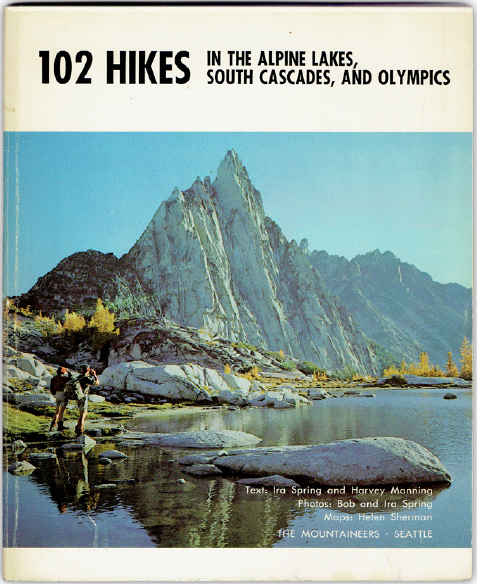
A squabble over climbing styles nearly tore The Mountaineers apart in its early years. Choosing instead to put differences aside, that turmoil spawned a text so seminal that it would come to be read religiously by aspiring climbers around the world. Mountaineering: The Freedom of the Hills is now seen by many as the pinnacle of climbing education material, and next to it since the beginning is the nonprofit publisher Mountaineers Books.
Early on, the need for a reference text became clear to climb
leaders in The Mountaineers. Wolf Bauer, the pioneer of our
rock climbing programs, became the source for much of the
information present in our first literary creation: the Climber’s Notebook. The 1940 notebook “contained information on how to tie knots, techniques for climbing on rock and snow, orientation, and first aid,” Jim Kjelsden wrote in The Mountaineers: A History. “Much of it is as useful now as it was a half-century ago, including such admonitions as ‘look back to the rear occasionally so you will recognize territory on return.’”
Wolf came up through The Mountaineers as part of a
restless body of young people in the 1920s and 30s who
banded together to climb unsanctioned by the club. Known
as “outlaw climbing,” the practice was controversial at best
and measured on the Richter scale of discord at worst. Since
climbing techniques at the time marred the landscape, leaving
behind metal spikes called pitons in cracks in the rocks, the
practice went against the strong conservation ethic of The
Mountaineers. This difference in perspectives almost caused
the club to collapse.
Seeking common ground, Wolf started a sanctioned climbing
program using techniques he learned from European
instruction books. The information shared in his and others’
climbing lectures went on to be the basis for instruction in
the Climber’s Notebook and throughout The Mountaineers for
decades to come.
In 1954, the climbing committee, low on stock of the 1940
handbook, saw an opportunity to update the 15-year-old
information. Harvey Manning, a former chair of the climbing
committee and well-respected Mountaineer, was tasked with
organizing the revision of the text. In September 1955, he
called a meeting of all the current and past committee leaders
he could find. In a quote from Kjelsden’s history book, “’the
group then gathered to consider the material,’ Manning
says, adding with characteristic humor, ‘they met on four consecutive nights, and the members who remained by the
fourth night became the book editorial committee.’”
Years were spent developing, reviewing, redeveloping,
and re-reviewing the material. Each chapter was redrafted
multiple times as the editors worked to balance information
and uniformity with tone and feeling. Sometimes words just
wouldn’t cut it, and visuals were needed to compliment the
concepts. Tom Miller drew stick figures to start, and other
artists like Dee Molenaar and Donna Balch also contributed to
give the book its distinct illustrations.
As challenging as writing and editing the book proved to be,
its financing was just as difficult. In August 1956 the Book
Finance Committee was formed to determine how to pay for
it. The Board budgeted $3,000 for the project in 1956, but
eventually 101 people lent an additional $15,000 to the project
to make it a reality.
By 1960, they had a book, but were still without a title. With no
shortage of books called Mountaineering, Harvey came up with
the enduring subtitle, “The Freedom of the Hills.” Today, the book is most commonly – and affectionately – known as Freedom.
An initial printing of 5,000 copies was ordered, and the
editorial committee members assumed the print run would
last half a decade. The order didn’t last a year. It seemed the
text was just as popular outside of the club as within, and
everyone who had loaned money to the book was repaid
within a few short months.
Freedom’s editors agreed that the book’s proceeds would
have the most impact reinvested into publishing projects,
and in 1968 the board of trustees established the literary
fund committee with the purpose of financing "the publication, from time to time, of such books, pamphlets, or other
educational material,” Kjelsden wrote. “They couldn’t have predicted that ‘from time to time’ would eventually come to
mean publishing a new book nearly every week of the year.”
With 60 years of history to look back on, Mountaineers Books achievements in recreation, conservation, and outdoor education are incomparable. It’s doubtful that Harvey and the editorial committee members could foretell their course textbook project would grow into an active catalog of over 700 titles. Over time, we’ve discovered that books with powerful and evocative messages change lives, and in some cases, the direction of history.
Over the last six decades, Mountaineers Books titles have
changed the way residents of the Pacific Northwest and
beyond look at and enjoy our outdoor spaces. One of our most
transformative early books was written by Louise Marshall, 100 Hikes in Western Washington. Alongside Bob and Ira Spring, Louise published the first of many 100 Hikes guides, which have introduced tens of thousands of people to the power of the outdoors, many for the first time. Harvey Manning and Ira Spring wrote many of the following 100 Hikes books, and today local guidebook author Craig Romano has taken up the mantle, updating their earlier works with more than 20 Mountaineers Books titles introducing yet more people to the outdoors, including our new and popular Urban Trails series.
Fred Beckey, one of the most important first-ascensionists and
mountain explorers North America has ever seen, documented
and described the Cascades for generations of climbers in his
Cascade Alpine Guides. His titles are still some of the most
detailed references available. We continue to share guides, like
Mount Rainier: A Climbing Guide and Washington Scrambles,
to support future climbers, and publish skill-based titles, like
Crack Climbing: A Definitive Guide and Gym to Crag, to share
skills and make the outdoors accessible to everyone.
Our conservation publishing footprint is huge as well. Were it
not for The North Cascades, published in 1964, our beautiful
North Cascades National Park containing the American Alps
might not exist. The Alpine Lakes, published in 1971, “is credited with saving the Alpine Lakes Wilderness from a presidential veto,” wrote Kjelsden.
“I sat down with the President and opened the book,” recalled former Washington State Governor Dan Evans, in an interview for Mountaineer magazine in 2017. “That 15 minutes turned into 45 minutes. Aides kept coming in and saying, ‘Mr.
President, you have to get to the next meeting; you have to
go.’ And he just kept leafing through that book, lost. You know
he was an Eagle Scout, a hiker, a lover of the outdoors himself,
and, as a result, the Forest Service took a back seat, he signed
the bill and Alpine Lakes was created."

Through our Braided River imprint, titles are published each year that work to protect the last wild places in western North America. Works like Seasons of Life and Land and Caribou Rainforest have been essential to the protection of vast landscapes and the animals and people that rely on them. Our recent book, We Are Puget Sound: Discovering and Recovering the Salish Sea, supports citizen engagement, advocacy work, and changes to public policy, with an ambitious goal to restore
and protect salmon and orca habitat.
Our Skipstone imprint shares lifestyle-focused titles that you can thank for the wonderful backcountry enchiladas you found in Dirty Gourmet, or the backyard goats you’re considering bringing home after you read City Goats: The Goat Justice League's Guide to Backyard Goat Keeping.
To carry forward this legacy, we’re investing in titles and series to make the outdoors more accessible to a diverse demographic of current and future recreationists. Our books are actively changing what it means to be outdoorsy, introducing people to all of the ways you can enjoy the outdoors, including beekeeping, gardening, foraging, car camping, and exploring city parks.
Freedom laid the foundation for over a half-century of
publishing history. As a testament to itself, its ninth edition
was released in 2017. While the publishing process for Freedom
is now managed by a team of professionals, the words are still
100% written by volunteers.
What will climbing and outdoor recreation look like 60 years
from now? That’s unclear. However, it’s safe to say that
Freedom and Mountaineers Books will still be here to guide
climbers young and old, new and seasoned, in their mountain
pursuits. Many outdoor dreams begin in the pages of a book,
and we’re proud to help bring those pages to life.
Main image of Harvey Manning. Photo courtesy of Mountaineers Books.
The original article incorrectly identified Harvey Manning as the first author of a 100 Hikes book. This text has been updated to reflect Louise Marshall’s authorship.
This article originally appeared in our Spring 2020 issue of Mountaineer Magazine. To view the original article in magazine form and read more stories from our publication, visit our magazine archive.
Add a comment
Log in to add comments.Bob Cram's illustrations in the early editions of Freedom of the Hills, deserve credit in any historical account. His fame as the skiing weatherman on TV helped early sales, and his art still works for the Mazama Store and Community Club.
 Trevor Dickie
Trevor Dickie